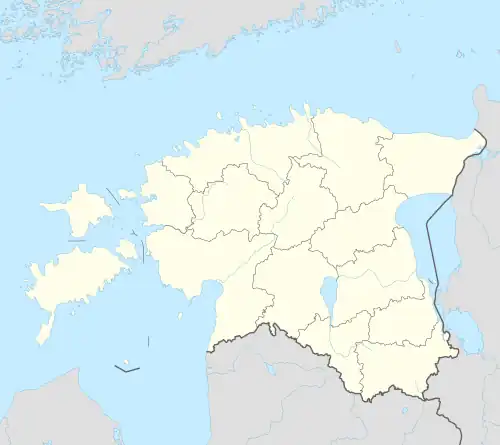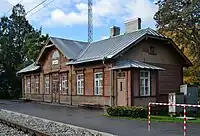Riisipere | |
|---|---|
 A train in Riisipere railway station | |
 Riisipere | |
| Coordinates: 59°07′14″N 24°18′33″E / 59.12056°N 24.30917°E | |
| Country | Estonia |
| County | Harju County |
| Parish | Saue Parish |
| Population (2004) | |
| • Total | 1,051 |
| Time zone | UTC+2 (EET) |
Riisipere (German: Riesenberg) is a small borough (alevik) in the Saue Parish, Harju County, Estonia.[1] Prior to the administrative reform of Estonian local governments in March 2017, Riisipere was the administrative center of Nissi Parish. Located on the Ääsmäe-Haapsalu road, its distance from Tallinn is 45 km, from Haapsalu 50 km, Märjamaa 30 km, Rapla 40 km.
The town
Riisipere railway station, the terminus of the Elron Tallinn-Keila-Riisipere line, has been electrified since 1981. Originally the line continued to Haapsalu. The Riisipere–Haapsalu section was abandoned in 2004,[2] but is due to be rebuilt as far as Turba during 2019, as a first step towards eventually re-opening the line to Haapsalu (and possibly the port at Rohuküla ).[3]
Part of the Riisipere is called Nissi. Near Nissi is the Nissi Church. In Nissi, there is a community house, a monument for the Estonian War of Independence and a cemetery. The first mentioning of Nissi (as a village) was in Danish Census Book.[4]
Apart from the manor, Nissi Church is the main place of interest.[5] The church was built in 1873 and designed by St. Petersburg architect David Grimm.[6]
The composer Raimond Valgre was born in Riispere in 1913.[7]
Riisipere manor
Riisipere manor (German: Neu-Riesenberg) traces its origins as an estate back to 1394. It has been owned by various well-known Baltic German families over the centuries. The present building was built in 1818-1821 during the ownership of Peter von Stackelberg. The grandiose building is one of the finest examples in Estonia of Neoclassical manor house architecture. The front façade is dominated by a six-column portico with a truncated ornamental gable and two three-storeyed side projections. The interior displays an enfilade of representative premises, including a cupola hall, unique in Estonia, and a richly decorated hypostyle "white hall", abundant with details in stucco. The manor is surrounded by a park with an artificial lake.[8][9]
Gallery
 Riisipere manor house
Riisipere manor house.jpg.webp) Nissi church
Nissi church Riisipere train station building
Riisipere train station building.jpg.webp) Water tower in railway station
Water tower in railway station
References
- ↑ Riisipere www.efqy.com
- ↑ "Eesti Raudteemuuseum" (in Estonian). Archived from the original on 2009-09-07. Retrieved 2008-12-09.
- ↑ "Go Track to build Riisipere - Turba railway" (in Estonian). Retrieved 2018-12-30.
- ↑ EE, Eesti entsüklopeedia. [Encyclopedia of Estonia] A-Ü. Tallinn: Valgus. 2003. p. 367. ISBN 9985701410.
- ↑ "904 Nissi kirik, 1873.a. Mälestised", Kultuurmälestiste (in Estonian), retrieved December 23, 2013
- ↑ "Church of Blessed Virgin Mary in Nissi on Visit Estonia". Retrieved 19 December 2012.
- ↑ "Raimond Valgre Elulugu", www.miksike.ee (in Estonian)
- ↑ Sakk, Ivar (2004). Estonian Manors - A Travelogue. Tallinn: Sakk & Sakk OÜ. pp. 36–37. ISBN 9949-10-117-4.
- ↑ Viirand, Tiiu (2004). Estonia. Cultural Tourism. Kunst Publishers. p. 54. ISBN 9949-407-18-4.
External links
- Riisipere matkad.elektriaudtee.ee
- Riisipere manor on Estonian Manors Portal
| Preceding station | Elron | Following station | ||
|---|---|---|---|---|
| Jaanika towards Tallinn |
Tallinn–Turba/Paldiski | Turba Terminus | ||
